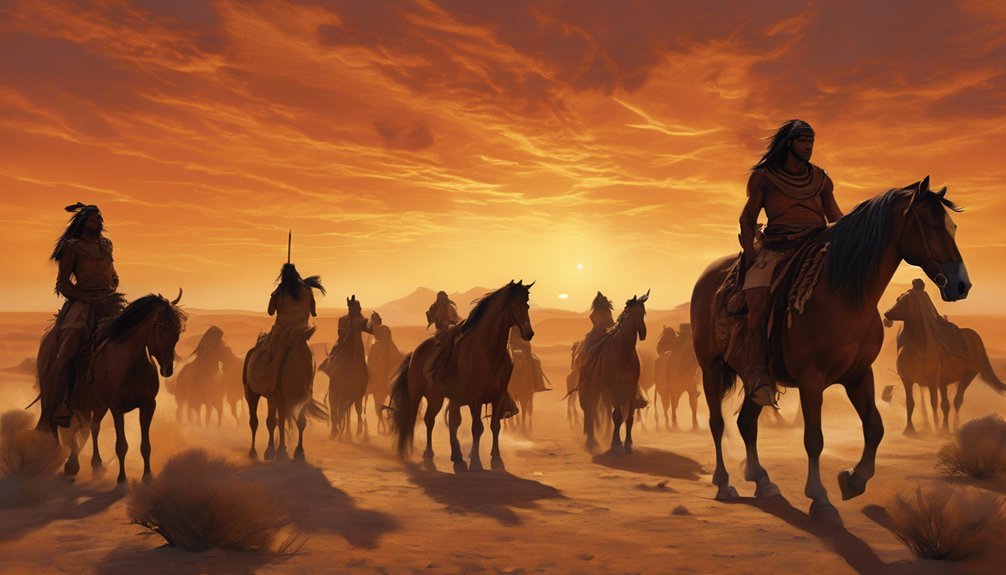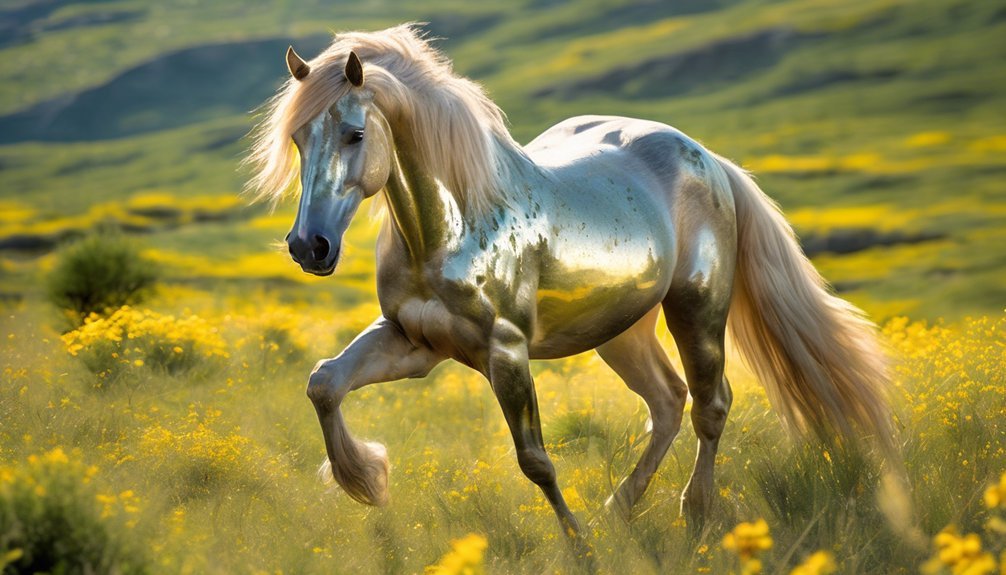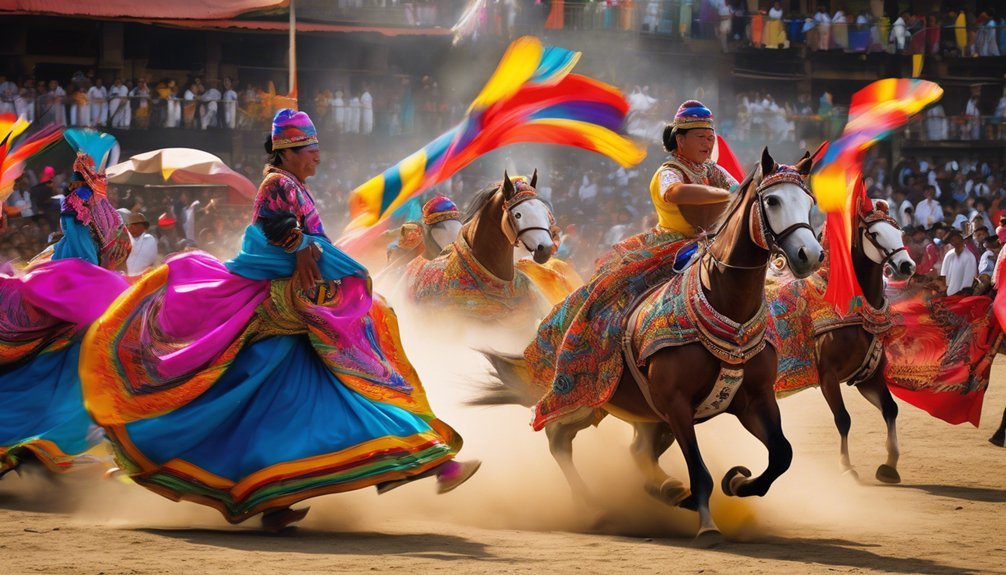
The arrival of the Spanish horse in the Americas reshaped indigenous life in ways you might not expect. It revolutionized transportation, hunting, and agriculture, leading to profound cultural shifts. Horses became more than just animals; they represented power, freedom, and a new way of life. As you explore this transformation, consider how these changes influenced warfare tactics and community identity. The implications are far-reaching and may challenge your understanding of these cultures.
Key Takeaways
- The introduction of Spanish horses revolutionized transportation, transitioning indigenous peoples from walking to riding, enhancing mobility across the Americas.
- Horses transformed hunting practices, enabling indigenous groups to access resources more efficiently and redefine their survival strategies.
- In agriculture, horses improved land cultivation and livestock management, significantly impacting food production and trade.
- The mounted tactics of Spanish conquistadors in warfare instilled fear and disrupted indigenous societies, altering power dynamics in the region.
- Equestrian traditions developed from this exchange, blending Spanish techniques with indigenous practices, fostering community identity and cultural pride.
The Arrival of the Spanish Horse in the New World

When Spanish explorers first set foot in the Americas in the late 15th century, they unknowingly brought with them a powerful catalyst for change: the horse.
These majestic animals, with their diverse horse breeds, transformed landscapes and livelihoods. As indigenous peoples encountered the horses, a profound cultural exchange unfolded. You can imagine the awe felt as they observed the speed and strength of these creatures, leading to new forms of transportation and hunting techniques.
Over time, the horse became woven into the fabric of daily life, fostering connections between communities. This exchange wasn't merely transactional; it redefined identities and established new relationships, paving the way for a future where the horse would symbolize both power and freedom in the New World.
Transforming Indigenous Cultures
As you explore the impact of the Spanish horse on Indigenous cultures, you'll notice profound shifts in traditions and daily life.
The horse not only transformed transportation methods, making travel more efficient, but also redefined hunting practices, allowing for greater mobility and access to resources.
Additionally, equine symbolism began to weave itself into local traditions, reflecting a deeper connection between people and these powerful animals.
Equine Symbolism in Traditions
While the introduction of Spanish horses to the Americas marked a significant shift in transportation and agriculture, it also profoundly impacted the symbolic landscape of Indigenous cultures.
You might see how these majestic creatures became woven into the fabric of equine mythology, embodying power, freedom, and spirituality. In various cultural ceremonies, horses emerged as sacred symbols, often representing the connection between the earthly and the divine.
They took on roles in rituals, signifying strength and resilience during times of hardship. As you immerse yourself in these traditions, you sense the deep reverence Indigenous peoples hold for horses, viewing them not just as animals, but as vital participants in their stories, dreams, and communal identities, forever transforming their cultural expressions.
Changes in Transportation Methods
How did the introduction of Spanish horses reshape transportation methods for Indigenous cultures in the Americas? The arrival of these majestic creatures transformed daily life, making travel more efficient and enhancing ranching techniques. With horses, you could transport goods over vast distances, and horse-drawn carriages became a new symbol of mobility.
| Traditional Method | New Method |
|---|---|
| Walking | Riding horses |
| Canoes | Horse-drawn carriages |
| Pack animals | Mounted herding |
| Foot trails | Horse trails |
| Slow travel | Faster, longer journeys |
As you embraced these changes, your connection to the land and people deepened, paving the way for cultural shifts that would resonate through generations.
Impact on Hunting Practices
The introduction of Spanish horses didn't just revolutionize transportation; it also fundamentally altered hunting practices among Indigenous cultures in the Americas.
With the arrival of various horse breeds, hunters found themselves equipped with speed and agility previously unattainable on foot. You can imagine the thrill as they adapted their hunting techniques, using horses to chase down game like deer and buffalo across vast plains.
This shift allowed for greater efficiency and larger catches, transforming subsistence methods. Communities began to form around these new practices, fostering deeper connections to the land and the animals they hunted.
As you explore these changes, it's clear that the Spanish horse didn't merely enhance hunting; it redefined the very essence of Indigenous life and culture in the Americas.
The Role of the Spanish Horse in Agriculture
Harnessing the power of the Spanish horse transformed agricultural practices in the Americas, enabling farmers to cultivate land more efficiently and effectively.
With their strength and agility, these horses became vital partners in:
- Crop cultivation, allowing for quicker plowing and planting.
- Livestock management, making it easier to herd and transport animals.
- Transportation of goods, which streamlined market access for farmers.
- Enhanced labor, freeing up time for other essential tasks.
As you observe the fields, you can sense the harmony between farmers and their Spanish horses.
This relationship not only increased productivity but also shaped the very fabric of rural life, fostering a deep bond built on trust and mutual benefit.
The legacy of these horses in agriculture remains profound and enduring.
Impact on Warfare and Conquest

In addition to their significant role in agriculture, Spanish horses played a pivotal part in shaping the course of warfare and conquest in the Americas.
Imagine the sight of conquistadors mounted on these powerful animals, their speed and agility redefining military tactics. You can see how they outmaneuvered indigenous forces, whose resistance was often hampered by a lack of cavalry.
The emotional weight of this imbalance mustn't be overlooked; as Spanish riders charged, they instilled fear and awe. The psychological impact of the horse transformed encounters from mere battles to devastating conquests.
For indigenous peoples, the horse symbolized not just a physical threat but a profound disruption of their world, challenging their very way of life and survival.
The Development of Equestrian Traditions
As Spanish settlers established their presence in the Americas, they didn't just bring horses; they laid the groundwork for a rich tapestry of equestrian traditions that would evolve over centuries.
You can see how these traditions flourished through various forms of expression, including:
- Equestrian sports that showcased skill and bravery
- Cultural festivals celebrating horsemanship and community
- Unique riding styles blending Spanish techniques with indigenous practices
- Storytelling and music reflecting the bond between horse and rider
These elements intertwined, creating a vibrant culture where horses weren't just transportation but symbols of identity and pride.
The Spanish horse became a catalyst for a dynamic relationship between people and their steeds, influencing everything from daily life to celebratory events, fostering a deep-rooted passion that resonates even today.
The Legacy of the Spanish Horse Today
While the arrival of the Spanish horse in the Americas marked a revolutionary change in transportation and agriculture, its legacy today extends far beyond practical uses. The influence of Spanish horse breeds, such as the Andalusian and the Paso Fino, shapes modern equestrian cultures and practices. You'll witness how these breeds are not just animals but symbols of identity and tradition, reflecting deep cultural adaptations over centuries.
| Spanish Horse Breeds | Cultural Significance | Modern Adaptations |
|---|---|---|
| Andalusian | Dance and art | Dressage |
| Paso Fino | Festivals | Gaited riding |
| Azteca | Heritage | Ranch work |
| Criollo | National pride | Endurance riding |
In every stride, the Spanish horse tells a story of resilience and connection.
Frequently Asked Questions
What Breeds of Spanish Horses Were Introduced to the Americas?
You'll find that breeds like the Andalusian, with its rich origins, and the Mustang, shaped by evolution, reveal fascinating stories of resilience. Each horse's journey intertwines with human history, creating a deep, lasting connection.
How Did the Spanish Horse Influence Native American Social Structures?
The Spanish horse reshaped your social structures, symbolizing power and status. As you embraced horse symbolism, it elevated societal hierarchy, fostering connections and rivalries that defined your community's dynamics, ultimately transforming relationships and leadership roles.
Were There Any Negative Impacts of the Spanish Horse on Indigenous Peoples?
You might wonder about the darker side of this majestic creature. Indigenous peoples faced cultural displacement and intensified resource competition, altering their way of life, sometimes leading to conflict and loss that overshadowed any newfound advantages.
How Did the Spanish Horse Affect Trade Networks in the Americas?
The Spanish horse transformed trade routes, enhancing your ability to navigate vast distances. You witnessed increased economic exchanges, as tribes engaged more efficiently, allowing goods to flow faster, enriching cultures and fostering connections across the Americas.
What Role Did the Spanish Horse Play in the Development of Rodeo Culture?
The Spanish horse is a brushstroke on the canvas of rodeo culture, shaping techniques through cultural exchange. You'll see how riders mastered skills, blending tradition and innovation, creating an enduring legacy that celebrates both heritage and artistry.
Conclusion
As you reflect on the profound impact of the Spanish horse, consider how this majestic creature not only transformed transportation and warfare but also wove itself into the very fabric of indigenous identity. What stories might the horses tell if they could speak? The echoes of their hooves still resonate in the traditions and cultures they shaped. The legacy of the Spanish horse endures, hinting at untold chapters of history just waiting to be uncovered.





